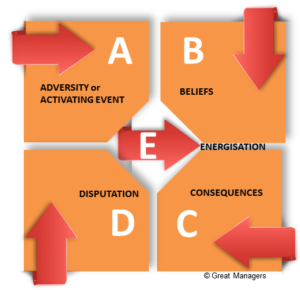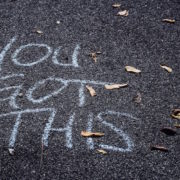Optimism – a Proven 5-Step Model to Upgrade your Thinking System
Begin Your Optimism Upgrade using the ABCDE Model
I’m going to share a proven technique with you to develop your Optimism called The ABCDE Model.
The first part of this model (the ABC part) was originally developed by Psychologist Albert Ellis and it’s been added to by Seligman and many other experts.
The ABCDE Model is a method for building optimism by recognising and disputing pessimistic thoughts. The key to disputing your own pessimistic thoughts is to first recognise them and then work with them as if they were uttered by someone you really cared about and wanted to help you…(That’s you, by the way). This model is a proven way of upgrading your thinking system. Let’s have a look at how you can use this model in your life…
Building Optimism – A is for Adversity
A stands for Adversity or Activating events. Basically, what happened.
When we encounter Adversity we react by thinking about it and our thoughts rapidly develop into beliefs, particularly if we use these same thoughts often. The purpose of this model is to give you a way to disrupt that automatic thinking.
Building Optimism – B is for Beliefs
B stands for Beliefs, which is how you interpret the event… how you’re thinking about it. The idea here when you’re using this model is to record what you were saying to yourself in the midst of the adversity. This is why you need good self-awareness. You need to get very clear on what’s running through your mind. You need to download all that jibber-jabber that can be going on in your mind in the middle of adversity. Write it down! Especially when you’re just starting to practise this model, write it down verbatim. Don’t censor it or worry about being polite.
You need to very clearly capture your thinking. Because the thinking is happening fast and a lot of it is unconscious, so you want to make it more conscious.
You need to:
- Reflect on what you’re actually thinking and how you’re interpreting or explaining the event to yourself.
- Be Aware of the stories you’re telling yourself
- Think about the sort of language you’re using
We know that certain kinds of thinking habits can trigger responses such as helplessness. But other beliefs you hold might be positive and supportive, so you need to find out what they are! However, it can be quite hard to identify our thinking because it happens so fast!
In the Great Managers Academy, we teach the S + T = R Model to help leaders do this more skillfully and quickly. That’s one to practice! Hopefully, you know what I mean by that, if you’re a member or familiar with our Academy. You’ll find it in Strategy 2 of the program. Get in touch if you’d like to know more about it.
Building Optimism – C is for Consequences
C stands for Consequences which captures how you feel after the event.
What are you feeling? What’s happening in your physiology? Is your physiology escalating in terms of your state? What are you doing with your behaviour?
This part of the model can be an alternative starting point if you get derailed by feelings or emotions and you’re not sure where they came from. The idea of this part is you start by asking yourself, “What am I feeling?” and being able to identify and label your feelings is an important aspect of Emotional Intelligence.
Many people find this hard initially, but it improves considerably with practice. It’s just like any other skill, the more you practise it, the better you get at it. Most people have not learned about emotions as a skill throughout their life. They just pick up bits and pieces along the way.
We talk about this a lot in the Great Managers Academy and how important this skill is. It’s another skill that we teach and it’s another skill that we want you to practise regularly so that you can develop this skill to a level of mastery.
Building Optimism – D is for Disputation
The next part of the model is where you activate free will or choice, and you start to look for distortions or pessimistic patterns in your thinking and dispute them. This is where the change in your thinking begins. D stands for Disputation.
There are 4 elements of effective Disputation.
- Look for Evidence.This is about countering your pessimistic beliefs and you might hear yourself say something pessimistic and you counter it by saying, “Based on what? What facts do I have to support this belief?” and then you can look for alternative explanations because almost nothing that happens to you in life has just one cause. Most events have a range of possible causes.
- Find Alternatives. Rather than latching on to a permanent or pervasive explanation, try to Find Alternatives that might be less destructive for you, or for your relationships, or for the situation.
- Explore the Implications of your Beliefs. This is called de-catastrophising. It’s very important that you are aware of when you’re turning something into a drama unnecessarily because this will escalate you and the amygdala hijack will take over and it’ll be hard to pull out of.
On a regular basis, just be aware of where you’re turning something into a drama. You might be talking about the traffic a lot, or the weather, or what someone else was doing to you. It’s about being able to pull-up in those simple moments so you can develop this skill. Practise de-catastrophising regularly. - Examine the Usefulness of your Beliefs. Sometimes the consequences of holding a belief, matter more than if the belief is true. Ask yourself, “Is that belief destructive?” Many relationships have been fractured permanently because people believe they’re 100% right, and the other person is 100% wrong. While your ego loves to be right, perhaps the relationship may be more important than that temporary win.
To get better at this part of the model you can ask a trusted friend to help you dispute a belief if you feel stuck with your beliefs. If you feel like you’re in the grip of a belief. But make sure you’re very clear with this trusted friend about what you’re trying to achieve otherwise they might help you justify that belief and you don’t want that when you’re working towards building Optimism.
What Else Can you Do?
You can also Distract yourself by turning your attention elsewhere or you can Distance yourself from your beliefs. To change thinking patterns long term, it’s better to capture them and find a lasting remedy. It’s better to replace non-supportive thoughts with something that helps you get an emotionally intelligent outcome.
E is for Energisation
E stands for Energisation or Execution. This is what you do or choose to think instead and how you feel as a result of making these choices. The idea at this point is to reflect on the positive impact on yourself and others as a result of your more positive response. It might be asking yourself something along the lines of; “What did I learn from challenging my habitual thinking in this situation?” “How are you feeling now having made that choice?” and “What actions are you taking?”
Ready to learn how to apply this model in your business and your life? View the full MasterClass here… Great Managers® MasterClass Series
Subscribe to the PODCAST of the Great Managers® MasterClass











